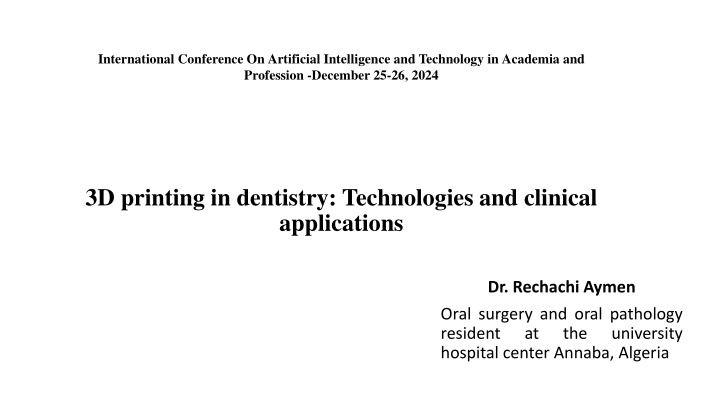
Innovations in 3D Printing for Dentistry: Technologies and Applications
Explore the impact of 3D printing in dentistry, from cutting-edge technologies to clinical uses. Discover how this modern process revolutionizes patient care with precision, customization, and efficiency, while addressing challenges and discussing the future outlook.
Download Presentation

Please find below an Image/Link to download the presentation.
The content on the website is provided AS IS for your information and personal use only. It may not be sold, licensed, or shared on other websites without obtaining consent from the author. If you encounter any issues during the download, it is possible that the publisher has removed the file from their server.
You are allowed to download the files provided on this website for personal or commercial use, subject to the condition that they are used lawfully. All files are the property of their respective owners.
The content on the website is provided AS IS for your information and personal use only. It may not be sold, licensed, or shared on other websites without obtaining consent from the author.
E N D
Presentation Transcript
International ConferenceOnArtificial Intelligence and Technology inAcademia and Profession -December 25-26, 2024 3D printing in dentistry: Technologies and clinical applications Dr. Rechachi Aymen Oral surgery and oral pathology resident at hospital center Annaba, Algeria the university
Plan : Introduction 3D Printing Technologies in Dentistry Materials Used in 3D Printing Clinical Applications of 3D Printing in Dentistry Benefits of 3D Printing in Dentistry Challenges and Limitations Future of 3D Printing in Dentistry Conclusion
Introduction: 3D printing is a modern process that builds three-dimensional objects layer by layer from a digital design. In dentistry, it is changing how treatments are done by improving accuracy, saving time, and allowing for customized care. This presentation will explain the technologies behind 3D printing and how they are used in dental treatments to improve patient care and outcomes.
1/3D Printing Technologies in Dentistry: Types of 3D Printing Technologies Used:SLA (Stereolithography): High precision, suitable for dental models and aligners. DLP (Digital Light Processing): Faster than SLA, used for crowns, bridges, and surgical guides. SLS (Selective Laser Sintering): Used for metal frameworks like partial dentures. FDM (Fused Deposition Modeling): Affordable, used for basic dental prototypes..
2/Materials Used in 3D Printing: Common Materials: Resins (biocompatible for dental models, crowns). Metal alloys (titanium, cobalt-chromium for implants). Thermoplastics (used in orthodontics and temporary restorations). Highlight biocompatibility and cost-effectiveness. Include an image of various 3D printing materials.
3/Clinical Applications of 3D Printing in Dentistry: Surgical Guides: Custom templates for precise implant placement. Prosthetics: . Crowns, bridges, and dentures fabricated with speed and accuracy. Orthodontics: Clear aligners and retainers designed and printed in-house. Models and Molds: Diagnostic models for treatment planning and patient communication. Maxillofacial Reconstruction: Custom prostheses for facial deformities.
4/Benefits of 3D Printing in Dentistry: Precision: High accuracy in dental restorations and surgical planning. Customization: Tailored solutions for individual patient needs. Efficiency: Faster workflows, reduced chairside time. Cost-Effectiveness: Lower material waste and reduced lab fees.
5/Challenges and Limitations: Initial Costs: High investment in 3D printers and materials. Training Requirements: Need for specialized skills and expertise. Material Constraints: Limited options for certain dental applications. Regulatory Issues: Standards for biocompatibility and safety.
6/Future of 3D Printing in Dentistry: Advancements in Technology: Development of faster printers and more durable materials. Integration with AI: Improved planning and precision through AI-driven workflows. Increased Accessibility: Lower costs and more widespread adoption in general practices. Focus on Sustainability: Eco-friendly materials and reduced waste.
Conclusion: 3D printing has revolutionized dentistry by enabling precision, efficiency, and innovation. While challenges remain, advancements in technology and materials will continue to expand its applications. Emphasize its potential to improve patient care and outcomes.
